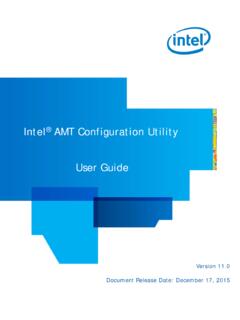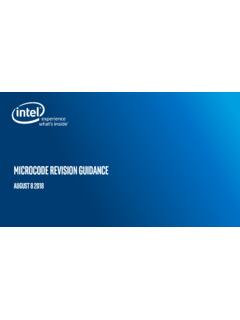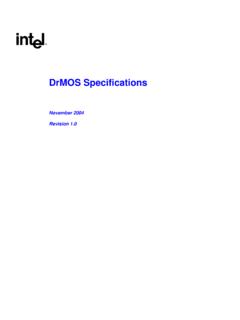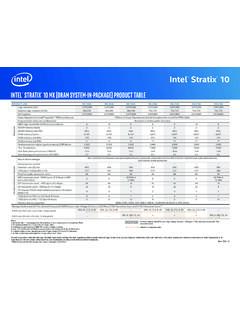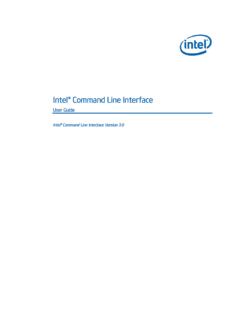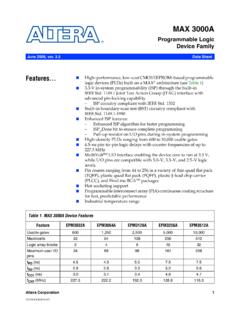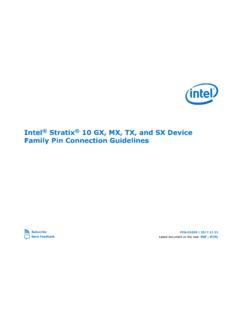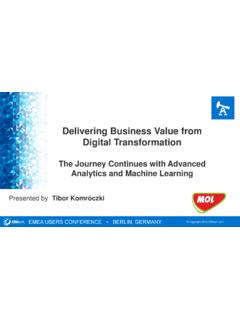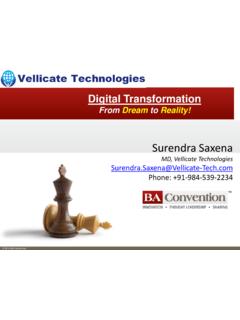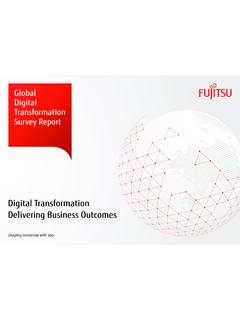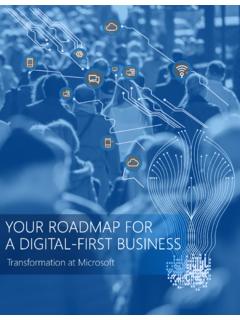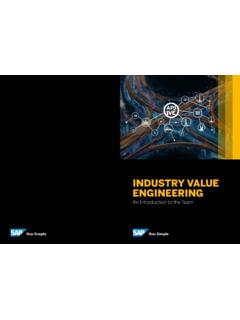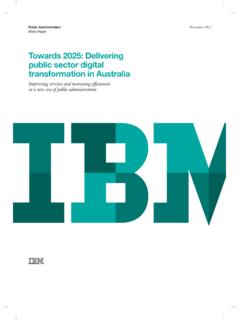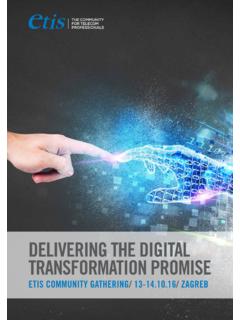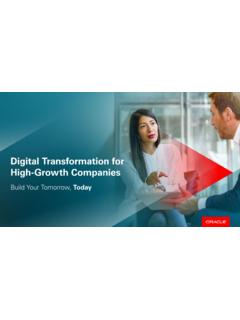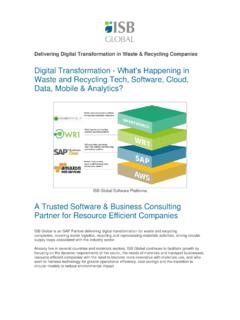Transcription of Business Transformation for the Digital Age - intel.com
1 White PaPerData Center IT TransformationExecutive SummaryThe demands of the new Digital economy have made IT more essential to Business success than ever before. IT now enables Business Transformation , helping organizations compete, grow and innovate. As the role of the IT organization shifts from service provider to an enabler of Business innovation, the CIO can maximize the current opportunity to become a change maker and deliver on the needs of the Business . Digital Transformation is achievable, and the CIO can deliver real, technology-driven change based on a new, modernized infrastructure. Disruption is The New NormalTechnology-driven disruption is driving new urgency around Digital Business Transformation initiatives in every industry. Fueled by innovative cloud-connected services, and emerging trends such as artificial intelligence (AI), the era of data-driven Business is forcing organizations to either transform or be disrupted.
2 Business today must either capitalize on the benefits of technology to deliver more efficient processes, new customer experiences and new Business models or simply face becoming irrelevant as their innovative, more nimble peers pass them CIO and the IT organization are at the center of this disruption, driving both Business and IT Transformation and modernization strategies, harnessing technology for competitive advantage and identifying new growth opportunities. The CIO now must anticipate future Business needs and create the capability to deliver Business value to the customer, while at the same time assuring stability of existing systems during the modernization do this successfully requires a holistic Transformation of both Business processes and IT infrastructure. Most enterprise modernization efforts are done incrementally, modernizing some applications and deploying new infrastructure opportunistically as specific needs arise.
3 Against the background of an increasingly dynamic market landscape, this approach is becoming less and less effective. As Forrester Research tell us: CEOs and boards have become increasingly aware that making incremental changes to the Business may not go far enough; doing too little or going too slowly may place their firm at risk as they compete in a customer-led, digitally driven market. IT s Critical Role in Transforming the EnterpriseBusiness Transformation for the Digital AgeTable of ContentsExecutive Summary ..1 Disruption is The New Normal ..1 Guiding Principles of IT Transformation ..2 Managing Technical Debt and Architecting IT Strategy for the Digital Age ..2 delivering on Digital Transformation . 4 References and Resources ..5 White Paper | Business Transformation for the Digital Age 2In this paper we will outline core principles associated with IT Transformation initiatives and offer guidance on building the right Digital foundation for your Business .
4 We will cover: The guiding principles of IT Transformation How to manage your technical debt and architect a Digital Business platform How intel can help you execute your Transformation strategy and deploy a modern, cloud-ready infrastructure Guiding Principles of IT TransformationToday s modern CIO oversees a data-driven enterprise that operates in a multi-cloud world and where IT is a strategic ally in achieving Business goals. Transforming the Business into an insights-driven, cloud-enabled and operationally efficient enterprise in the data era requires a focus on the following five principles: 1 . GROW COMPETENCY IN ADVANCED ANALYTICS TO DRIVE Business Transformation & COMPETITIVENESS Data insights are the currency of Digital Business and advancing analytics competency is key to the success of Digital Transformation initiatives.
5 The success of these efforts requires a holistic and comprehensive data strategy and a modern data foundation. The right infrastructure components will handle the complex demands of rapidly emerging workloads such as machine and deep learning that use AI technologies. 2 . ACCELERATE SERVICES INNOVATION AND TIME-TO-MARKET WITH HYBRID CLOUDSR apid service innovation and delivery with a hybrid cloud strategy is essential to conduct Business at a pace demanded by the velocity of the data era. Evaluating hybrid cloud strategies with a best-of-breed approach allows enterprises to realize the unique benefits of both public and private cloud usage models to accelerate Business agility while maintaining critical stability where needed. When combined with a smart workload placement strategy, hybrid clouds enable CIOs to run a no-compromise IT environment and both transform and modernize at the same time.
6 3 . REMOVE NETWORK BOTTLENECKS FROM EDGE TO CLOUD TO THE DATA CENTER Increasing network traffic volume, complexity and the increased use of cloud computing makes the network and its management a critical success factor for IT Transformation initiatives. Enterprises need increased flexibility and the ability to maximize their network resources to enable intelligent, dynamic networks. With software-defined approaches and network function virtualization, networks can respond automatically to changing Business needs and provide the necessary speed, agility and consistent application experience across multi-cloud environments. 4 . MANAGE, SECURE AND ACCESS YOUR DATA WITH FUTURE-READY STORAGEData is exploding, arriving from previously untapped sources with a volume and velocity that can easily overwhelm traditional IT systems. New capabilities around advanced analytics and AI-driven data analysis are creating the ability to leverage that data to gain new insights for enhanced competitiveness.
7 IT must create a data strategy that is guided by Business objectives to unlock this data, and efficiently and securely pre-position it for ready use when needed by the Business . 5 . DEPLOY MULTI-LAYERED STRATEGY FOR SECURITY FROM THE PLATFORM UPThe attack surface for the enterprise continues to grow as more and more devices connect to enterprise networks and the Internet, and IT moves more workloads to the cloud. Combined with the growing volumes of valuable data and the industrialization of hacking, CIOs must deploy a multi-layer security strategy that protects from the platform up, ensures data encryption at all stages of use and can proactively hunt the threats on the network through the use of analytics and machine learning. Each of these principles plays a critical role in the IT Transformation journey on its own, but they are interconnected with dependencies on each other for success.
8 This is why a holistic approach to Transformation is required, where modernization happens across the infrastructure, application and cloud environments to create a Digital Business platform that will fuel growth and innovation. Managing Technical Debt and Architecting IT Strategy for the Digital AgeThree Step Process to ModernizationUnencumbered by legacy IT, many Digital startups have embraced platform-based models to create new forms of Business value and rapid growth. For these companies, IT strategy starts with an understanding that, while services may change frequently, underlying infrastructure should offer a stable and standardized foundation that can meet the dynamic needs of the Business . Indeed, the more stable and agile the foundation, the more effectively new services can be created and deployed, accelerating growth and this kind of infrastructure is challenging for enterprises with massively complex portfolios of systems and software.
9 However, successful Business and IT Transformation can be achieved with a holistic strategy that determines what applications are needed by the Business and identifies the right platform model that will deliver optimal performance, stability and efficiency. White Paper | Business Transformation for the Digital Age 3 Figure 1 . IT Transformation requires a comprehensive understanding of the legacy environment, proper workload placement and a tuning of cloud infrastructures for optimal performance. Figure 2 . An application migration rationalization process combined with a workload placement assessment helps determine the Business value of legacy applications and their optimal placement in public, private or hybrid models.
10 Application Rationalization and Workload Placement Evaluation Is CriticalCIOs today must modernize their existing infrastructure ( technical debt ) and Business processes while at the same time deploy new technologies and applications that will drive Business growth. This process starts with a complete assessment of the application portfolio in order to determine what workloads are needed, how they should be modernized, and what the optimal infrastructure is for each. It is critical in this process to fully understand the technical requirements, such as data size, integration, security, and performance, as well as the future pace of innovation required for each workload, as this will shape both placement and infrastructure investment decisions. If a placement decision is made to move a workload to a public, private or hybrid cloud, decisions on how to optimize the infrastructure required to ensure optimal performance and ROI.
